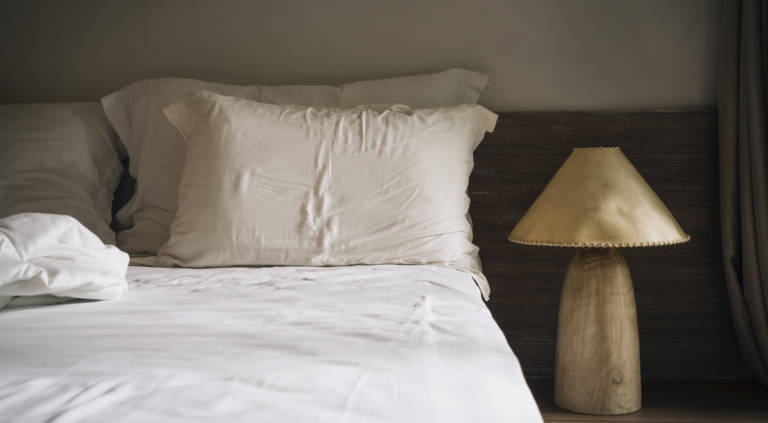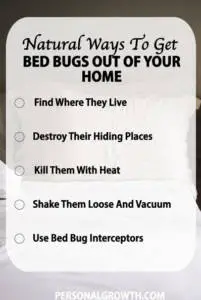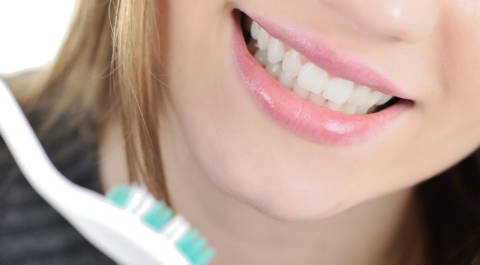
We've all had to deal with mosquito or spider bites, and some of us may even have had to deal with fleas – but what about bed bugs? These nasty little pests are enjoying a resurgence thanks to an increase in travel.
Like Organic Soul on Facebook
People sleep in an infested hotel, and the bed bugs hitch a ride back in their clothing or luggage; if you visit the home of one of these people, even if you aren't a traveling type yourself, the bed bugs will happily come home with you, too.
While bedbugs don't carry disease, they can deliver an itchy bite just like a flea can, and they give you the horrible anxious feeling of knowing you're sharing your bed with thousands of bloodsucking parasites.
Don't despair; you can stop the bed bugs from biting without having to resort to a bunch of toxic pesticides.
1. Find Where They Live
Although they're called “bed bugs,” they don't only live in your bed. Bed bugs might have infested your furniture, your hamper, your luggage, your carpet, or any number of other places. Since they like to feed at night, they're most likely to be in your bed, your pet's bed, or your favorite chair for late-night TV binges.
Bring a flashlight and check the area thoroughly. Look for live bugs, but also keep your eyes peeled for rust-colored splotches, like spots of dried blood. Bed bugs leave those behind when they're crushed, and they also tend to have a reddish tint to their stool.
Look for live bugs, but also keep your eyes peeled for rust-colored splotches, like spots of dried blood. Bed bugs leave those behind when they're crushed, and they also tend to have a reddish tint to their stool.
Bed bugs can get into spaces as narrow as a credit card, according to the EPA , so you might also find traces of bed bugs between an outlet and the wall, or in the back of a drawer, or in the cracks around your door frame. They're experts at hiding.
2. Destroy Their Hiding Places
Bed bugs like to hide in dark crevices. That usually means hiding between the cushions on your furniture, or between the mattress and the sheet or box spring, but it doesn't have to.
Tidy up the clutter around your house so that bed bugs have fewer places to hide. Seal up cracks in the wall and glue down any peeling wallpaper. The cleaner your house is, the less attractive it will be for bed bugs.
3. Kill Them With Heat
Prolonged high heat is a terrific way to kill bed bugs. According to the EPA, bed bugs die when they reach 113 degrees Fahrenheit (45 degrees Celsius).
In most cases, your best bet is your washer and dryer. Wash your bedding and any removable upholstery in the hottest water possible, and then dry it on the highest setting your dryer can manage.
Dry your laundry with high heat as much as possible, too; bed bugs love hampers and may hitch a ride in your clothes. If you have stuffed animals, decorative pillows, or other items that need to be hand-washed, try either submerging them in a sink full of hot water (test it with a thermometer to make sure it reaches the critical 113-degree mark first) or running them in the dryer without washing them first.
If you live in a hot climate, you may also have some luck putting items like luggage in black plastic garbage bags and putting them in direct sunlight for a few hours.
4. Shake Them Loose And Vacuum Them
Sucking up bed bugs in the vacuum cleaner is an effective way of killing them, but if you want to get as many bed bugs as possible, you need to shake them loose first.
Take a stiff-bristled brush and scrub the surfaces where you found evidence of bed bugs; this will help you to pull them loose so they aren't clinging to the mattress when you bring out the vacuum cleaner.
Then vacuum those surfaces to pull the bed bugs up and away from your house. Seal the vacuum bag up immediately and dispose of it outside of your house; otherwise, you'll just be moving the infestation to the hall closet or the kitchen trash can.
Repeat this every day. You won't be able to vacuum up all of the bed bugs at one go, but the more often you vacuum, the more you'll catch.
5. Wrap Up Your Mattress
Special, bed bug-proof encasements are an effective and non-toxic way to make your home less welcoming to bed bugs.
When you wrap your mattress and box spring in the encasements, you accomplish two things.
Firstly, any bed bugs that live on the surface of your mattress or box spring will be trapped inside.
They won't be able to get through the encasement to bite you, which will result in you getting fewer bites and the bed bugs starving to death.
Secondly, any bed bugs that weren't living on your mattress or box spring will be unable to nest there; they might be able to get onto the surface of the encasement, but the smooth fabric provides them with far fewer places to hide when you attack with your brush and vacuum.
6. Use Diatomaceous Earth
Diatomaceous earth, a powder made from the fossilized remains of tiny prehistoric plankton, is a highly effective and non-toxic cure remedy for bed bugs.
The trick is to make sure that you use food-grade diatomaceous earth, which is safe for humans but deadly to bed bugs. Sprinkle it on the area that's been infested.
The diatomaceous earth will bond to the bugs' exoskeletons, covering them with tiny holes and causing the bugs to dehydrate and die.
It's a mechanical reaction rather than a physical one, which means that bugs can't become tolerant to it in the way they can develop resistance to pesticides (like how bacteria can develop resistance to antibiotics, but not to bleach or alcohol).
 Large amounts of diatomaceous earth can be dangerous if inhaled, so use it in moderation.
Large amounts of diatomaceous earth can be dangerous if inhaled, so use it in moderation.
7. Use Bed Bug Interceptors
Bed bugs may be good at hiding in dark places, but they have trouble climbing on slippery surfaces. In order to stop any bed bugs in your room from getting into your bed and biting you, try using specially made bed bug interceptors. These interceptors are plastic cups that go under each of your bed posts.
They have a small “moat” around them so that any bed bugs trying to climb up the bed posts to reach you will have to climb up the slippery sides of the moat and will end up falling into the moat of the interceptor instead.
Pull the bed away from the wall so that the bed bugs can't crawl up the wall to get to you, and make sure that no blankets or dust ruffles are touching the floor.
By using bed bug interceptors and denying the bugs any way of climbing up except for your bed posts, you'll be keeping the bugs out of your bed and depriving them of their main food source: you.
















